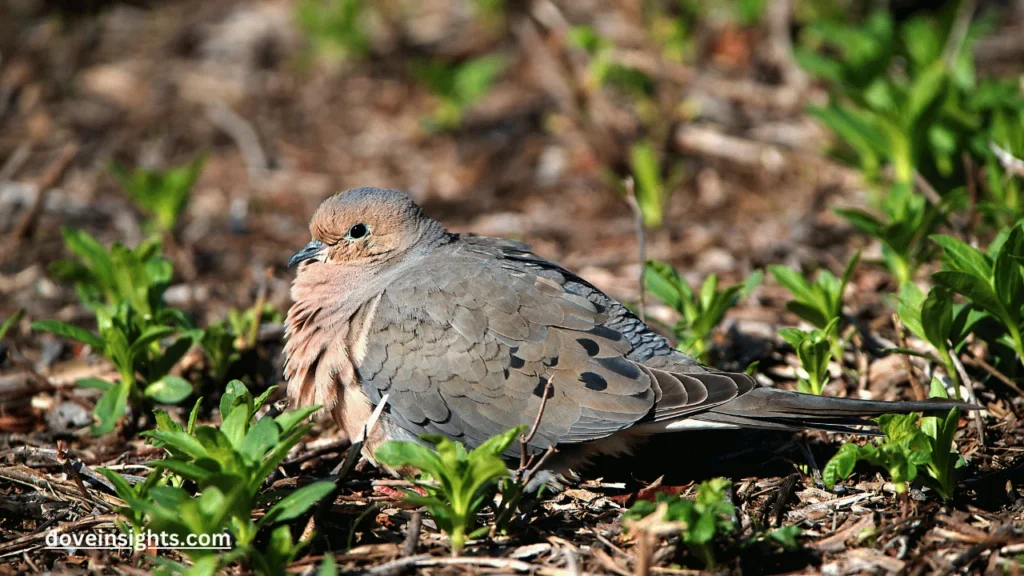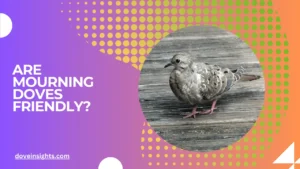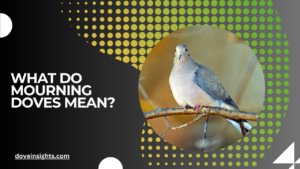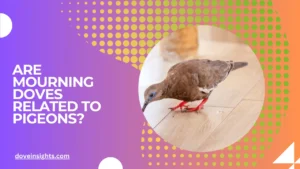When you think of mourning doves, the first images that likely come to mind are their gentle coos and graceful flight patterns.
But as with all living creatures, mourning doves also have a biological side that includes regular waste elimination. If you’ve ever wondered what mourning dove poop looks like, you’re not alone.
Although it may seem like an odd question, understanding the appearance and composition of their droppings can give us insight into their diet, health, and even their environmental interactions.
This article will delve into the world of mourning dove poop, explaining its color, shape, and consistency, and what these characteristics can tell us about the bird’s well-being.
Whether you’re a birdwatcher, a homeowner dealing with dove droppings, or simply curious about the intricacies of nature, this guide will provide valuable insights into one of the less-discussed aspects of mourning dove behavior.
Contents
What Mourning Dove Poop Looks Like: The Basics
Mourning dove poop is distinctive and offers a few key characteristics that make it relatively easy to identify. Color and shape are the primary features that stand out.
The droppings of mourning doves typically consist of three parts: a dark, solid portion, a lighter, chalky portion, and sometimes a liquid part. T
he solid part is dark brown or green, reflecting the high-protein seeds and grains that mourning doves consume. The chalky white portion is the bird’s uric acid waste, which is a result of their metabolism of proteins.
Unlike mammals, birds like mourning doves excrete waste as a combination of urine and feces, which results in this chalky consistency. The liquid portion is usually a clear or slightly yellowish fluid that represents the bird’s urinary output.
Together, the droppings are generally small and oval-shaped, often found in clusters or small piles near the bird’s favorite roosting spots.
The chalky consistency can make the droppings easier to clean, but it can also create stains on surfaces where they accumulate.
What Mourning Dove Droppings Can Tell Us About Their Diet
The diet of a mourning dove has a direct influence on the appearance of its droppings. As mentioned, mourning doves are primarily granivores, meaning they eat seeds, grains, and sometimes small fruits or berries. The color and texture of their droppings reflect this diet.
For example, the dark brown or greenish color of their solid waste is a result of the high levels of chlorophyll in the seeds they consume.
Doves that eat more sunflower seeds, millet, or sorghum may produce droppings that are particularly dark. If the dove’s diet is more varied and includes fruits, the droppings might have a slightly different hue, such as a reddish or yellowish tint due to pigments in the food.
The chalky white portion is the result of the doves’ metabolism of nitrogen, which is excreted in the form of uric acid.
This aspect of their droppings is typical for birds, as they do not have kidneys that excrete liquid urine in the same way mammals do. Instead, they eliminate waste in the form of semi-solid uric acid, which helps conserve water.
How Mourning Dove Poop Relates to Their Health
Mourning dove poop can be a useful indicator of the bird’s health. Like any animal, a sudden change in the appearance of their droppings can signal a health issue or dietary imbalance. For example:
- Greenish, runny droppings could indicate that the mourning dove has been eating too many seeds or poor-quality food.
- Blood in the droppings could be a sign of internal parasites or other digestive issues that might require veterinary attention.
- If the droppings are consistently watery and lack the solid portion, it might suggest dehydration or an infection affecting the dove’s digestive system.
If you’re regularly seeing mourning dove droppings in your yard, it’s helpful to observe them closely. Healthy droppings should be relatively consistent in color and texture. If you notice changes or oddities in the droppings, it might be a sign that the bird is ill or has altered its diet.
The Environmental Impact of Mourning Dove Droppings
Mourning dove droppings, like the droppings of most birds, can have a noticeable environmental impact. On a smaller scale, their droppings provide nutrients to the soil, especially if they are deposited in places where plants are growing.
The organic matter in the droppings breaks down and contributes to the soil’s fertility.
However, if you’re a homeowner, you may find that mourning dove droppings can also cause some issues. Large accumulations of droppings can lead to unsightly stains on rooftops, patios, and vehicles.
Over time, the acidic nature of the chalky white portion of the droppings can even corrode surfaces.
Moreover, if there are multiple mourning doves roosting in one area, the accumulation of droppings could create health hazards. The droppings may contain pathogens or parasites, which can affect both humans and other animals if not managed carefully.
What to Do If You Find Mourning Dove Poop Around Your Property

If you have mourning doves frequenting your yard, it’s likely you will encounter their droppings from time to time. While their droppings are not harmful in small amounts, regular clean-up is a good practice to keep your outdoor space safe and tidy.
Here are a few things to keep in mind:
- Clean up regularly: Use gloves and a shovel or scoop to remove the droppings. This helps prevent build-up and minimizes any damage to your property.
- Use a disinfectant: After removing the droppings, it’s a good idea to clean the area with a mild disinfectant to kill any potential pathogens.
- Check for nesting: If you notice a large number of droppings, you might want to check if mourning doves are nesting nearby. Mourning doves often build their nests in trees, shrubs, or on rooftops. Be careful not to disturb the nest or the birds.
If you want to discourage mourning doves from roosting in certain areas, consider using bird deterrents like netting, spikes, or reflective objects to discourage them from settling in those spots.
Conclusion:
While it may seem trivial, understanding the appearance of mourning dove poop can reveal important details about their diet, health, and behavior. The typical dark, oval-shaped droppings with a chalky white portion are a reflection of their granivorous diet and their unique metabolism.
Whether you’re a birdwatcher, a homeowner, or simply a curious observer, mourning dove droppings provide us with a fascinating glimpse into their natural world.
Regular attention to these droppings can help us detect potential health issues, and mindful cleaning practices can ensure that both the birds and the humans around them stay safe and healthy.
FAQ’s
What does healthy mourning dove poop look like?
Healthy mourning dove poop is typically dark brown or green, with a chalky white portion and sometimes a liquid component. It should be small and oval-shaped.
Can mourning dove poop be harmful?
In general, mourning dove poop is not harmful. However, large accumulations can lead to stains or even surface damage, especially in acidic environments.
Why is mourning dove poop white?
The white part of mourning dove poop is uric acid, which is a byproduct of their metabolism. Birds excrete uric acid as a way to conserve water, unlike mammals, which produce liquid urine.
Can mourning dove poop indicate disease?
Yes, changes in the appearance of their droppings, like runny poop or the presence of blood, could indicate health problems, such as parasites or digestive issues.
How can I clean mourning dove poop from my property?
Use gloves to remove the droppings with a scoop or shovel. Afterward, clean the area with a disinfectant to prevent the spread of bacteria or pathogens.
Do mourning doves poop while flying?
Like most birds, mourning doves do excrete waste while flying, although they generally do so when perched or resting.








